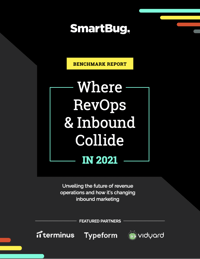
A Crash Course on RevOps from INBOUND 2021
October 18, 2021
By Ale Melara
RevOps has quickly become the go-to route to boost operational efficiency and profit, technology is racing forward and the corporate landscape is shifting quickly.
To keep the steam up from last week’s INBOUND we’re bringing one of the hottest topics throughout this year’s conference: RevOps (Revenue Operations) with a recap from industry leaders on how they’ve scaled their teams with RevOps and left us with tips on how to build our RevOps strategy from the ground up.
RevOps is on most leaders’ priority list, is it on yours?
NOTE: Powerhouse Pass Attendees will have access to the INBOUND 2021 virtual event platform for 1 year from today to rewatch any session on-demand.
A Crash Course on RevOps
Click here to watch the on-demand recording of the session; note that you must have an INBOUND 2021 Powerhouse Pass to view.
Alison Elworthy - HubSpot EVP, RevOps
Rosalyn Santa Elena - Neo4j VP, Global RevOps
Maggie Butler - HubSpot Builder - Marketing Team Manager
This session discussed three main points:
- Why RevOps is important?
- The benefits of RevOps
- The why’s the how’s and what to’s of RevOps
How do you define RevOps?
- Processes, systems, and people that control how your business generates revenue
- The process of unifying your internal ops teams
- infrastructure, people process and technology, and data that powers your revenue engine
“Alignment and unification is at the heart of RevOps”
Why consider RevOps as a strategy?
- There’s an increasingly complex buyer journey, customers have more access to information and expect a value-driven partnership, RevOps helps to align all of those touchpoints across this buyers and customer journey.
- The buyer is now in the driver's seat, they interact with technology and not just with your sales reps
- The importance of data and connected systems has grown exponentially, alignment is going to be your foundation to enable growth and scale.
- One system and one data model to put insights from is critical, that will help teams reach their goals
- There is a system or tool for everything and the need to keep them aligned because without this organizations face difficulties to get the insights on how the business is actually performing
- Rise of SaaS and recurring revenue models, there comes a shift to focus on the entire customer journey from, driving customer value and retaining within your current clients is important.
- You need to have a clear understanding of all the drivers that contribute to your bottom line
- Alignment and rigor across the revenue process, alignment not just between your teams but across cross-functional teams, having that enables organizations to have better visibility which leads to better predictability
- Align your teams and start working as a continuous flywheel organization because that is what is going to create that customer journey that was mentioned earlier
- Ops folks/departments are currently set up to be reactive, they’re underwater, ops folk react when something is broken, it's hard to get out of that mindset but what happens is that it tends to create a reactive mode. The sooner that you can start the better, the better you’re setting your team up for success.
- Ops was just an afterthought (before) but in the last 10 years or so it has been left but companies still hire too late.
How to create a RevOps strategy?
Have a plan and get aligned with your team behind the implementation and most importantly get the rest of the keyholders on board.
- Prioritize “customer-in” versus “function-out”. Believe that the customer experience is what is going to differentiate you from your competitors, have all your teams solving for the customer first.
- Build to be big and fast. Remove dependencies and foster dependencies between that will slow your teams down. As you grow you want to find a way to still remain fast and agile.
- Focus on foresight and build for long-term scale. Have the right insights to understand where the business is heading, it helps your teams to what they’re building for in the long run.
- Attract and develop remarkable ops talent and leadership. It all comes down to the people, make sure you have a strategy to attract and retain core talent and build a culture that enables and supports high-performing teams.
- Ensure alignment. Marketing, sales, and customer success but even, product, finance, etc. Everyone on the same team and no more silos, no more miscommunication.
- Deliver visibility. Through communication, transparency, and operational rigor. Everyone with the same level of visibility at the same time.
- Improve efficiency. Optimizing processes, policies, and systems.
- Connect the business. Everyone looking at the data and metrics the same way.
- Achieve revenue growth. By bringing all of this together RevOps drives revenue predictability that leads to revenue growth.
What does RevOps look like?
Six basic building blocks or pillars:
- Strategy and planning.
- Performance and metrics.
- Insights and analytics.
- Operational rigor.
- Enablement and optimization
- Technology and systems.
HubSpot’s RevOps structural model:
Wondering how inbound marketing connects with RevOps? Our team recently conducted a study to measure the impact of RevOps on budget, strategy, collaboration, and integrations and built a benchmarks report on RevOps, Inbound Marketing, and Technology.
Learn the latest trend on Inbound Marketing and RevOps in our “Where RevOps & Inbound Collide in 2021” benchmarks report.

About the author
Ale Melara is a Sr. Content Marketing Manager based out of El Salvador, Central America. Ale is our very first LATAM employee. She's worked remotely for the past 5 years and she's had different roles in sales and marketing. In her free time, she works on creating educational videos around digital marketing for her "Inbound Nomad" social accounts where she promotes traveling the world while being a full-time marketer. Read more articles by Ale Melara.




















